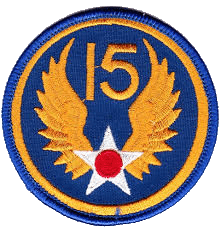Raymond C. Martin

B-24 Pilot, 826th Squadron, 484th Bomb Group, 49th Bomb Wing, 15th AF, Torreta, Italy. Flew 25 missions including Polesti oilfields (5/31/1944), awarded DFC.
The 484th Bombardment Group (H) was trained in Harvard, Nebraska in 1943 with B-24s and deployed to Italy in March 1944. Thegroup arrived in Cerignola, Italy where the gently rolling mounds of the Foggia plain awaited them. In pre-war days the Italian Air force trained near Foggia, too. The 484th BG took over farmland where wheat was once grown. Dual North and South runways were laid out and paved with crushed gravel, and later improved with pierced steel planking, a dubious improvement especially when it rained.
The group brought 60 new olive drab B-24s to the airfield at the Torretta crossroads about 12 K southwest of Cerignola, itself 35K south of Foggia. The group started out with about 3 trained crews of 10 men for every B-24. This would vary depending on losses and availability of replacements. In the one year of combat operations over 5,000 soldiers and airmen passed through the group. Replacements were brought in to fill in the Table of Organization (TO) due to casualties, illness and to replace flight crews who had finished their combat tours. For a battle area that was expected to offer light resistance tours were set at 50 missions. However resistance was stiff from both fighter aircraft and flak cannons. Credit was shortly reduced to 35 Missions, and modified again by giving double credit to long and arduous missions. Flight crews were given leave to rest camps at the halfway point of 18 sorties. Ground echelon personnel were given leave also when conditions permitted it. One such camp was on the Isle of Capri.
The B-24 Liberator Bomber

The Consolidated B-24 Liberator was designed and built in such great haste such was the need for a heavy bomber in 1939, when Germany invaded Poland. By taking the long Davis Wing and empennage from a twin-engine seaplane and installing them on an oval fuselage the B-24 was born. To improve ground handling visibility, the whole assembly was set on tricycle landing gear. The design was both good and bad, Good: The Davis Wing in combination with the supercharged Pratt & Whitney R-1830 engines and the Hamilton Standard hydromatic propellers worked well together. Bad: The nose wheel, built up of welded steel struts was too weak and failed when over stressed due to hard landings, strong cross winds, or rough runways. The fuel quantity indicators were of a simple boiler gauge style that required level flight for accurate reading, except that the aircraft actually flew slightly nose high to get additional lift from the fuselage. (The Lockheed Constellation was purposely designed to obtain fuselage lift). The fuel selector valves could be set for all engines to feed from the crossfeed manifold which held about 60 gallons. When this was used up all four engines would quit, not handy during the take off roll. The outboard auxiliary or Tokyo tanks of early model B-24s up to the “H” model did not have any fuel quantity gauges at all. When the fuel pressure dropped when feeding from these tanks it was time to transfer back to the mains before the engines quit.
In doing my research on Uncle Raymond, I was able to contact someone in the 484th Bomb Group Reunion Association. They were able to provide some additional information, including a picture of the crew and aircraft he flew from the USA to Italy.


Missions
Raymond went over as part of the Vance crew and flew 21 missions as part of that crew. He then was appointed pilot in command for his own aircraft and flew 9 missions until May 1945.






